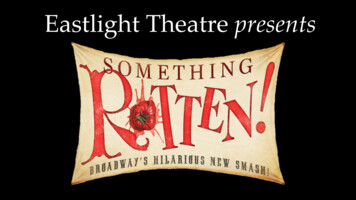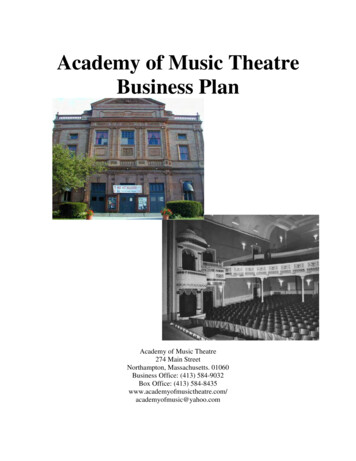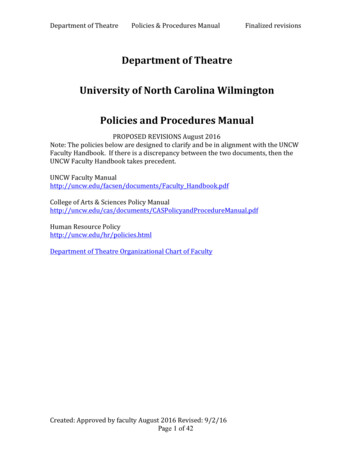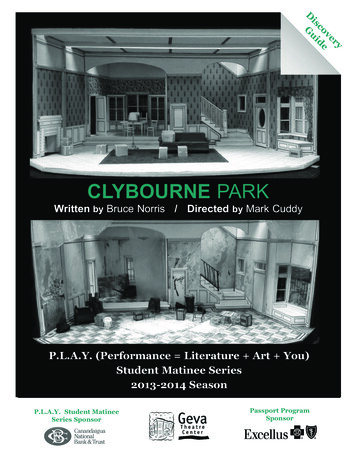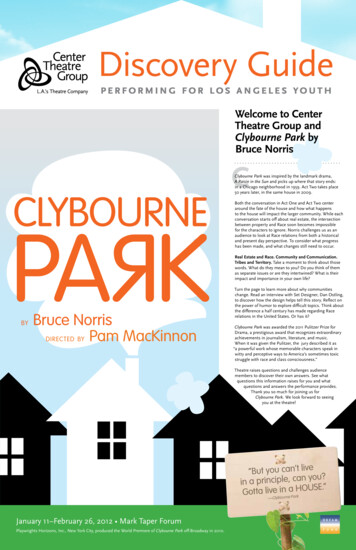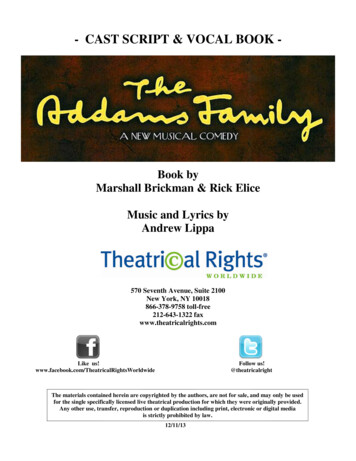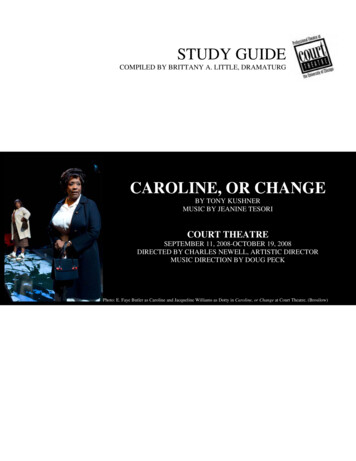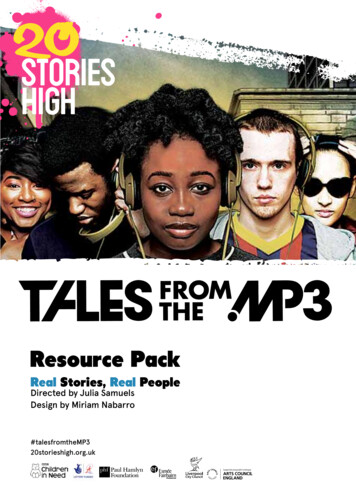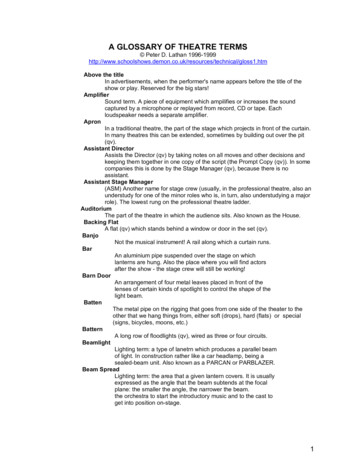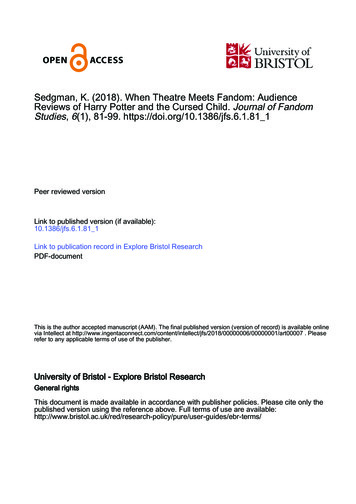
Transcription
Sedgman, K. (2018). When Theatre Meets Fandom: AudienceReviews of Harry Potter and the Cursed Child. Journal of FandomStudies, 6(1), 81-99. https://doi.org/10.1386/jfs.6.1.81 1Peer reviewed versionLink to published version (if available):10.1386/jfs.6.1.81 1Link to publication record in Explore Bristol ResearchPDF-documentThis is the author accepted manuscript (AAM). The final published version (version of record) is available onlinevia Intellect at s/2018/00000006/00000001/art00007 . Pleaserefer to any applicable terms of use of the publisher.University of Bristol - Explore Bristol ResearchGeneral rightsThis document is made available in accordance with publisher policies. Please cite only thepublished version using the reference above. Full terms of use are licy/pure/user-guides/ebr-terms/
Sedgman K – When Theatre Meets FandomWhen Theatre Meets Fandom: Audience Reviews of Harry Potter and theCursed ChildAbstract:The 2016 launch of the stage production Harry Potter and the Cursed Child presented fanswith their final opportunity - the first in nearly a decade - to reunite with the characters oftheir beloved series. Running in London’s West End since summer 2016 and due to transferto Broadway in 2018, Cursed Child presents an unusual case-study of what happens when anauthor working in other media chooses to revive their own storyworld only onstage. Thismakes it the ideal focus point to explore what happens when theatre and fandom collide.The play script was also published in book format, and quickly became the fastest-sellingtheatre script since records began. But what did audiences themselves make of this dualrebirth? This article explores how the live performance and the playtext were received byfans as very different forms of afterlife. This has prompted important questions aboutaccess. Presented with an extension to their beloved storyworld after so many years, whathappens when Harry Potter fans found themselves unable to actually take part in this newtheatrical experience? And to what extent was the publication of the script a faircompromise in return for audiences’ undying loyalty? This question has taken me on ajourney from the specific example of Cursed Child to a more general exploration of fan-ledefforts to democratise access to exclusive live events.Keywords: theatreaudience researchlivenessHarry PotteraccessdemocracyBiography:A theatre lecturer and researcher at the University of Bristol, Kirsty Sedgman asks howdifferent people make sense of live performance events. Her work explores the interplaybetween audiences, cultural value, fandom, community, and place. Her book Locating theAudience (published by Intellect in 2016) was the first to explore how people developedrelationships with a cultural institution at the time of its formation: the then brand-newNational Theatre Wales. She is currently working on a three-year British Academypostdoctoral research fellowship investigating audience engagements with regional theatrethrough time. Find her at www.kirstysedgman.com, or on Twitter at @KirstySedgman.Email:info@kirstysedgman.com1
Sedgman K – When Theatre Meets FandomWhen Theatre Meets Fandom: Audience Reviews of Harry Potter and theCursed ChildFriday 26 June 2015 was an exciting day for Harry Potter fans. Eighteen years after thepublication of Harry Potter and the Philosopher’s Stone, the first in her seven-book series, JKRowling took to Twitter to announce an eighth addition to the Potter canon: Harry Potterand the Cursed Child. Finally, the world’s most lucrative fictional universe was coming backto life.Except that Harry Potter’s sudden return has not in practice been quite as neat as thissuggests. First, Cursed Child is not the only afterlife that Rowling has granted her wizardingworld. On the global digital publisher Pottermore Rowling has periodically released shortexcerpts of her unpublished writing, with the traditional publication of spin-off books suchas Quidditch Through the Ages and The Tales of Beedle the Bard having further augmentedher universe. In this vein, at the same time as the development of Cursed Child Rowling wasalso working on Fantastic Beasts and Where to Find Them, a 2016 film about a wizard in1920s New York. Second, whereas Rowling was sole author of all seven Harry Potter books,this time she was working as part of a partnership, developing the story in collaborationwith two other creatives: Jack Thorne and John Tiffany. Third, and most significantly, whilethose seven stories were initially disseminated as novels, with the franchise becoming apublishing phenomenon on a previously unheard-of scale, Cursed Child was written as astage play, launching at the Palace Theatre in London in summer 2016.The play begins as the final book left off: with the primary characters waiting at thestation to send their own children off to Hogwarts. In an effort to minimise spoilers, sufficeit to say that the plot revolves around the evolving relationship between Albus Potter,second son of the books’ eponymous protagonist, and Scorpius Malfoy, whose father Dracowas Harry’s childhood nemesis. Both boys can be seen throughout the two parts of the playstruggling to navigate their identities around their fathers’ respective fame: Harry fordefeating Lord Voldemort and becoming the saviour of the wizarding world; Draco for hiscollusion in its near-destruction. When Albus and Scorpius are unexpectedly throwntogether, their friendship nearly undoes the trials-and-triumph timeline that readers soavidly followed all those years ago.2
Sedgman K – When Theatre Meets FandomBut of course in June 2015 none of this detail was known. All fans had to go on was aseries of tweets by Rowling herself, explaining simply that a new play was launching inLondon the following year, that it would be called Harry Potter and the Cursed Child, that itwould tell a new story - and that it would not be a prequel. Addressing the question of whythe story would not be novelised, Rowling simply expressed confidence that, having seenthe play, audiences would agree that this was ‘the only proper medium for the story’(quoted McGeorge 2015: np). If she were going to extend Harry Potter’s tale for one lasthurrah, only theatre would do.1 For this reason, I have chosen in this article to refer toCursed Child as a ‘rebirth’ of the Harry Potter world rather than, say, a ‘resurrection’, inorder to acknowledge audiences’ acute attention to how the characters’ much-awaitedreturn has happened through an entirely different kind of medium. As a live performancerather than a recorded or written text, and coming almost a decade after the publication ofthe final book (Harry Potter and the Deathly Hallows, released on 21 June 2007), CursedChild was to be fans’ final opportunity to reunite with the characters of their beloved series.The ‘liveness’ of the experience therefore became critically significant in reception terms. Ofcourse, any study of theatrical audience experience must consider the effects ofephemerality and performer-audience co-presence:2 but as this article hopes to show, whena text of such international popularity is turned into theatre, a whole new dimension to theliveness debate is unveiled. This is because via Cursed Child, to date, only a select handfulfrom the many millions of fans around the world have been able once again to wait onPlatform 9¾ at Kings Cross for the Hogwarts Express; to take part in a long-awaited reunionwith Harry Potter, Hermione Granger, Ron Weasley, Draco Malfoy, and others besides; to seethe changes wrought by time on their beloved characters, and to find out where the storyhas taken them after that final full stop.Potter’s rebirth is therefore a unique form of transition. Although countless belovedbooks - from Mary Poppins to Matilda to Of Mice and Men - have been adapted for thestage, and despite a strong history of using theatre as a space for extending stories (see e.g.Wicked’s prefiguration of Wizard of Oz), the Cursed Child play was the first prominentinstance in which an author has chosen to revive their own massively popular storyworld1Rowling was also adamant that Cursed Child should be a dramatic play as opposed to a musical (Crompton 2016).2The idea of liveness has been much theorised in performance studies, from Phelan’s (1993) and Auslander’s (1999) foundationalinterventions onwards.3
Sedgman K – When Theatre Meets Fandomonly onstage. Through studying Harry Potter and the Cursed Child, this article is thereforeable to ask what happens when a textual canon with a massive international following istransplanted into the West End. What have audiences themselves made of this transition?And what happens when theatre and fandom intersect?The Erasure of Fandom from TheatreIt is a truth widely acknowledged that the rich seam of fan studies has rarely extended intothe region of theatre. While performance studies has seen increasing interest inunderstanding audience experience (Reason et al 2015), there has still been remarkably littlescholarly attention paid to those theatregoers who self-define as fans. As a consequence, weknow very little about what happens variously when audiences see themselves as fans oftheatre itself, when audiences become fans of a particular show, or when audiences aredrawn into theatres via external fan engagement. Regarding any of these scenarios, and asthis section goes on to detail, only a handful of academics have been interested in exploringthe nexus between theatre and fandom.What makes this gap even more startling is the strong historical trajectory of theatrefan activity. Possibly the best overview of this history is provided by Caroline Heim, whosituates the emergence of theatre fan communities at around 1810: 'a time when the “starsystem” was gaining traction in the United States’ (2016: 42). In fact, in Textual Poachers(1992) Henry Jenkins explains that one of the earliest uses of ‘fan’ was to refer to femaletheatregoers, the so-called ‘Matinee Girls’, ‘who male critics claimed had come to admirethe actors rather than the plays' (2012: 12). But the roots of theatrical fandom stretch backeven further than this, as Heim so valuably explains. Her article proceeds to track theevolution of fandom from nineteenth-century Bowery B’hoys to the twentieth-centuryMatinee Girls into the twenty-first century army of ‘large, fiercely loyal Broadway theatre fancommunities’, who, like their counterparts before them, continue to forge communitiesaround favourite texts through strategies of appropriation and re-imagination (2016: 48). Bypurchasing merchandise, learning songs, and collecting multiple viewings, fans are able to4
Sedgman K – When Theatre Meets Fandomperform allegiance to their favourite shows and actors and to construct a sense of collectiveidentity. These practices have been afforded by new technological advances that enable fansto narrate and translate texts in fresh ways, and that also work to blur the line betweenperformer and audience. While the type of fan who attends a stage production due to anon-theatrical investment (most commonly a commitment to a starring actor) is more likelyto be a one-off attendee, Heim suggests, it is those whose commitment is to theatre itselfthat tend to be repeat audiences:Many of these communities are institutionalised by names that signify their identification with theproduction they follow: Phans (Phantom of the Opera), Hedheads (Hedwig and the Angry Inch),Fansies (Newsies), ROA-holics (Rock of Ages), Q-Tips (Avenue Q), Jeckies and Twickies (Jeykll andHyde), Hamilfans (Hamilton) and Rent Heads (Rent).’(ibid)Added to this, we have the theatrical nomads: those whose commitment is to Broadwaymore broadly, who see multiple shows on multiple occasions, and who will often travelacross the world to collect new viewings (ibid: 49). The latest demographics from the USA’sBroadway League signal the significance of these committed audiences to the New Yorktheatre ecology. While ‘devoted fans’ (i.e. those who attended fifteen or moreperformances) constituted only 5.5% of the audience in 2015/16, they accounted for over athird of all Broadway ticket sales (Broadway League 2016).3So how can we understand the erasure of fandom from theatre studies? Firstly, it is nosecret that fans themselves have been a source of concern and ridicule for decades - evencenturies. The Journal of Fandom Studies is one important vehicle by which fan scholars haveworked to legitimise fandom as an important subject for study4; yet still this researchtradition has encountered difficulties flowing into the cultural studies mainstream. Secondly,it is largely agreed that both audience research and fan studies have historically taken place‘on sites of struggle, where audiences were considered in some way to be at risk’, andthereby have tended to focus mainly on mass media forms of consumption rather than onaudiences’ less-worrisome engagements with ‘high’ art (Sedgman 2016a: xii). And thirdly,3No comparable data pertaining to heavily-committed fan activity is available for the UK’s West End.4See e.g. Francesca Coppa’s article ‘Fuck Yeah, Fandom is Beautiful’ (2014) for a robust analysis of the various waves of fan studies.5
Sedgman K – When Theatre Meets Fandomwhen applied to theatre, the very concept of ‘fandom’ itself takes on a particularslipperiness. This last point requires some unpacking.In Popular Theatre and Political Culture, Tim Prentki and Jan Selman identify anoverarching resistance to theatrical popularism, tracing an operational tension between ‘art,literally with a capital “A”, and commercial art products created for the mass market of theproletariat by unscrupulous capitalists’ (2000: 59). The productions that tend to capture themost intense fan attention, attracting commitment by audiences who unreservedly selfidentify as ‘fans’, tend to be those transnational entities that Dan Rebellato terms ‘pleasuremachines: vast theatrical mechanisms to generate rapture, exhilaration and joy’ (2011: np).This places the fan at the centre of a set of problematic assumptions, whereby it is supposedthat the spectacularisation of theatrical productions means there ‘is something not to betrusted about the kinds of enjoyments they produce’ (Sedgman 2016b: 41). These‘manufactured pleasures’ (ibid) are thereby charged with complaints of inauthenticity, seento feed into an experience economy that privileges easy enjoyment over aesthetic and/orpolitical engagement.In other words, people who call themselves fans within theatre contexts are oftencriticised precisely for being fans, because their fandom tends (more often than not) to getattached to the ‘wrong’ kind of theatre.5 Equally, Daisy Abbott (2015) identifies a queasinesswithin serious theatre criticism at the risk that casting media stars within theatrical roles willattract non-theatregoing audiences who are ill-equipped to handle the responsibility ofspectatorship. Speaking of Tom Hiddleston in the Donmar’s 2013 production of Coriolanus,Abbott suggests that while the influx of Hiddleston fans into theatre demonstrates a ‘cleardemand for cultural consumption of this actor in this role’ (2015: 1), the resultant debatesfrequently mobilised criticisms of fan behaviour for breaching etiquette. This position wasfurther reflected in the furious arguments that followed the publication in The Stage of anarticle by Richard Jordan (2016), asking if Game of Thrones fans who attended a productionof Dr. Faustus in order to see star Kit Harington in the leading role constituted ‘the worstWest End audience ever?’, as well as in the rabid media attention surroundingCumberbitches’ perceived misbehaviour at Benedict Cumberbatch’s Hamlet (Bradley 2015).5To be clear, this is not my position. In fact, it is a position which I have actively worked to refute. For example, see my article ‘What’sBigger than a Standing Ovation?’ (Sedgman, 2016b) for an explanation of the challenge that audience scholars are making to the idea of’authenticity’ in theatre.6
Sedgman K – When Theatre Meets FandomThis is not the place to deeply analyse the war that is right now raging between peoplecampaigning for the maintenance of theatrical etiquette and those who prioritise wideningaudience participation. Rather, my intention here is to unveil both a widespread mistrust oftheatre-based fan activity, and a connected - and collective - distaste of fan-engagedtheatrical texts. However, this is still only part of the story. It is my assertion that while thosewith advanced involvements in theatre (such as critics, academics, and makers) exhibitengagements that are as heartfelt, passionate, consuming, and committed as those of anyfan, they often resist mobilising the fundamental tenets of fandom in making sense of theirinvolvement. This position finds echoes in the work of David Román, who proposes a sharedsense within theatre studies that overt fandomundermines our scholarly project and reveals an uncritical love for theatre. The fear that our love oftheatre will call into question our critical capacities follows from our field’s efforts to credentializeitself against the charge of inconsequentiality. To indulge in our feelings of pleasure and more to thepoint, to write about them, is viewed as unprofessional, a form of fandom that should be relegated tothe publicists or left to our private theatre journals.(2002: ix)Román criticises the discipline for demanding we keep ’our love of theatre outside of ourscholarship’ (ibid). While there is evidence to suggest that the division between ardent andcritical modes of response is actually not so easily made,6 it is fair to say that theatreacademia has largely resisted either directly studying fan communities, or analysingspectatorial engagement via fan studies frameworks.7 Seth Soulstein has directly called for ablurring of this line between fandom and other forms of highly-invested audiencing. Whileprofessionally-implicated theatregoers might prefer to consider themselves a ‘connoisseur’or ‘aficionado’ of live performance, he argues, their ‘consumptive dispositions, and6In fact, there is a sense that the majority of theatre scholarship is driven by an overarching personal love of - and belief in - the power oflive performance. While it doesn’t talk about fandom specifically, I have always found Jill Dolan’s Utopia in Performance (2010) to be aparticularly powerful (and impressibly overt) explication of this passion for the subject.7There are of course a number of exceptions, some of which are cited in this article. For other valuable sources see e.g. Wolf (2007),MacDonald and Halman (2014), Biggin (2017).7
Sedgman K – When Theatre Meets Fandomexpression of those tastes, fit along a spectrum of what can be considered fan behaviour’(2012: 1). In other words: ‘You are a fan’ (ibid).8It is therefore time to pay attention to those instances where theatre and fandommeet. And where better to start than the moment when a massive franchise, trailing behindit an international fan network, suddenly crashed into the West End? In this regard, HarryPotter and the Cursed Child has been arguably the most significant theatrical event of thismillennium so far.“It’s Okay, But It’s Not My Harry Potter”: Reviewing Audience ReviewsThere is no better way to get quickly familiar with the legend of JK Rowling and herwizarding storyworld than to read Stephen Brown’s summary, ‘Harry Potter and the FandomMenace’ (2007). Because Rowling’s creation, Brown reminds us, is a legend inside a legend:a classic tale of good-versus-evil wrapped up in an inspirational rags-to-riches story. Singlemotherhood, writing in cafes to save on electricity; the inspirational train journey fromEdinburgh to Kings Cross; rejection after rejection; finally, the publisher who took a chancebecause his daughter begged him to, then slow-burn interest leading to skyrocketing salesfigures. A movie deal. Theme park attractions. Enough branded merchandise to deck out areal-life castle. The narrative that led JK Rowling to Harry Potter is almost as compelling asthe story itself.Except not really. Distributed in more than 200 territories in 68 languages and sellingover 450 million copies worldwide, the Harry Potter franchise sparked unprecedentedfervour in the publishing world (Thomas et al 2005). By the time of the launch of the finalbook (Harry Potter and the Deathly Hallows) Potter fever had reached its peak, with elevenmillion copies selling in the first 48 hours (New York Times 2007). Nine years later CursedChild sold 850,000 copies in the same timeframe, making it the biggest-selling edition of a8Francesca Coppa takes the link between theatre and fandom a step further, arguing persuasively that fandom itself is inherentlyperformative: because ‘in theatre, stories are retold all the time. Theatre artists think it's fine to tell to tell [sic] the same story again, butdifferently’ (236).8
Sedgman K – When Theatre Meets Fandomplayscript since records began in 1998 (Hutchison 2016). Meanwhile, the play itself has beenconstantly sold out since the box office opened, with the first batch of 175,000 priority seatsdisappearing inside eight hours. That is a rate of just over six tickets per second.Perhaps the most intriguing aspect of the Cursed Child phenomenon is the contrast inreception between those who have been able to watch the play live, and those who onlyresponded to the script. Reading through the respective reviews, it seems inconceivable thataudiences can possibly be talking about the same story. While reviewers who saw the stageplay tended to be extremely positive about the experience, people who only read the scriptwere much more likely to write - often at great length - about their disappointment. Thissection uses reception research approaches to examine the difference between reviews lefton online forums like TripAdvisor to the performance event itself, and those that weresubmitted to Amazon and Goodreads after having read the book. In doing so I was interestedin exploring how the live performance and the playtext were received by fans as verydifferent forms of afterlife. One of the significant outcomes of studying the nexus betweentheatre and fandom has been the question it provokes about access. Presented with anextension to their beloved storyworld after so many years, what happens when Harry Potterfans found themselves unable to actually take part in this new theatrical experience? And towhat extent was the publication of the script a fair compromise in return for audiences’undying loyalty? This question has taken me on a journey from the specific example ofCursed Child to a more general exploration of fan-led efforts to democratise access toexclusive live events.In total, the live event attracted 261 TripAdvisor reviews to date.9 Meanwhile, thescript has yielded a massive 309,781 Amazon and Goodreads reviews. In order to investigatereactions to the live event more deeply, I have therefore also needed to look at thediscussions that have evolved online via sites such as TheatreBoard.co.uk,BroadwayWorld.com, and Tumblr. However, whilst these discussions contain significantqualitative information, the process of studying TripAdvisor, Goodreads, and Amazon indetail has enabled me to draw out some quantitative data as well. This is because all threesites ask contributors to rate products on a 5-point star rating, which allowed me to capturea sense, admittedly partial and incomplete, of the levels of positivity provoked by each9This is obviously too a small a sample to draw out any firm generalisations. In addition to the other sources cited below, the reader maytherefore also want to see the results of a cursory Reddit questionnaire conducted by user dommitor (imgur.com/gallery/Duawa).9
Sedgman K – When Theatre Meets Fandommedium. Of course, reception research into online responses brings with it a number ofconsiderations. Firstly, it is important to note that these self-selecting responses do notnecessarily reflect the ‘quiet majority’ who have not left a review [Sedgman 2016b: 43).Secondly, it is necessary to consider the ethical implications of quoting online posts. Thischapter employs the ‘moderate disguise’ approach (Bruckman 2002), with online commentsincluded with their associated usernames and yet without links to the posts themselves. Thisis because of the context in which these responses were posted: as reviewers, I believe thattheir experiences and reactions deserve to be taken as seriously as those written bynewspaper reviewers and theatre bloggers, and yet I am cognoscent of the risk thatcommentators might not wish their profiles to be scrutinised in this context. I have also keptall quotations in the format they appear online without ‘cleaning up’ any spelling orgrammatical anomalies. This is to avoid assuming that as a researcher I know best whatothers are trying to say.10Taking into account the TripAdvisor reviews on the Attraction listing for the CursedChild show specifically, as well as those directed at the Palace Theatre more generally butwhich made reference to Harry Potter, responses to the stage performance wereoverwhelmingly positive: over 85% gave the performance five stars. However, if we excludethose reviews left on the Palace Theatre listing, the five-star rating shoots up to 92%.Fig. 1: TripAdvisor review ratings for Attraction and Venue listingsWhy separate these reviews? Because responses to the Palace listing often focused onanalysing the building and its facilities rather than the play itself. For example, Niki Wcomplained that ‘[w]e were on row f of the balcony and as you can see from the picsattached. it's the worst view you could get. [ ] Shame as from the tiny bits of the show Icould see. [it] was brilliant’. Similarly, looetay said that they were made ‘to feel like secondrate citizens’, with a ‘truly incredible play’ having been ‘utterly spoiled by the terrible seatsand conditions in the balcony’. From the ‘vertigo-inducing height’ to the unbearable heat(and its associated smells) to the cramped leg conditions, ‘I have never felt so hot and so illduring a performance’. While this vehemence was not confined to Palace Theatre reviews,10See e.g. Bore 2011, Williams 2011, Boyle 2014 for more on the ethical and practical considerations of using digital material posted in thepublic domain.10
Sedgman K – When Theatre Meets Fandomthose critiquing the Attraction listing were seemingly more likely to moderate theirnegativity with the awareness that the ‘proper’ subject for their analysis was the show itself,despite occasional difficulty separating the two. Take for instance Kai111, who concluded adescription of ‘excruciating’ knee pain with the proviso that ‘I do try to remove it from mymemory of the play so as not to ruin the experience for me. But seriously it was INHUMANE.[ ] And that's why I did not give this a 5. Because of the seats.’In her book The Discourse of Online Consumer Reviews, Camilla Vasquez drawsattention to the propensity of reviewers to make reference to the star ratings they assign.Many such references serve to justify reviewers’ decisions, and ‘[i]n doing so show that theyare able to discern, discriminate and be fair’ (2014: 54). Vasquez’s work presents a valuablereminder of the necessity to consider discourse in context: ‘[w]hether reviews are primarilypositive or negative, evaluation is clearly their primary function’ (ibid: 2). Furthermore,Maria Barrett’s analysis of reviews of Liverpool’s Royal Court Theatre suggests thatTripAdvisor affords users the ability to ‘relate their reflections in their own vernacular, to anaudience that may be imagined to be much like themselves. Consequently, [ ] the languagetends to be open and helpful, intending to encourage, guide, or warn others’ (2016: 58). Inthe case of Cursed Child, a number of reviewers specifically advised their readers tofamiliarise themselves with the Harry Potter canon before attending the play:Being a big Potter fan, I was destined to love this and can imagine that if you've not seen or knowmuch about Harry Potter (or even that you don't like it?!) this play probably isn't for you! There's a lotof references to the books and films throughout so a basic knowledge is necessary. Particularly aseveryone is expected to know Ron, Hermione and Harry - there's no real intro to their characters! Sowouldn't call this a stand alone piece. [Lydia J]For diehard Potter-Fans it's obviously a must-see and everybody even remotely fascinated by thePotter Universe will enjoy this performance. However, to follow the storyline one should be familiarwith the original works. It will otherwise be difficult to understand the fast moving plot as the playrarely makes an effort to explain neither setting nor characters or fictional historic references. PotterInitiates should therefore read the novels first before watching this amazing show. [Tirell]Only a handful of reviewers talked about booking tickets despite not being a Potter-loverbeforehand. For example, John S comments that ‘I’m not a huge Harry Potter fan, never read11
Sedgman K – When Theatre Meets Fandomthe books but have seen most of the movies. But I knew this play was a hot ticket and wouldbe a great experience’. John S was in the minority here: it was far more common to find fansreviewing the play specifically in order to recommend it to other fans. A couple of people didso via oblique reference to canonical Potterisms, indicating a desire to share the experiencewith a wizarding folk community (Lacoss 2002: 70):I booked these tickets well over a year out and I'm glad I had divination.I mean, devined howwonderful this play would be! The Theater was charming and the 5 program told a little bit of historyabout The Palace Theater as well as a handy guide to fantastic cast members
the final book (Harry Potter and the Deathly Hallows, released on 21 June 2007), Cursed Child was to be fans final opportunity to reunite with the characters of their beloved series. The liveness of the experience th
